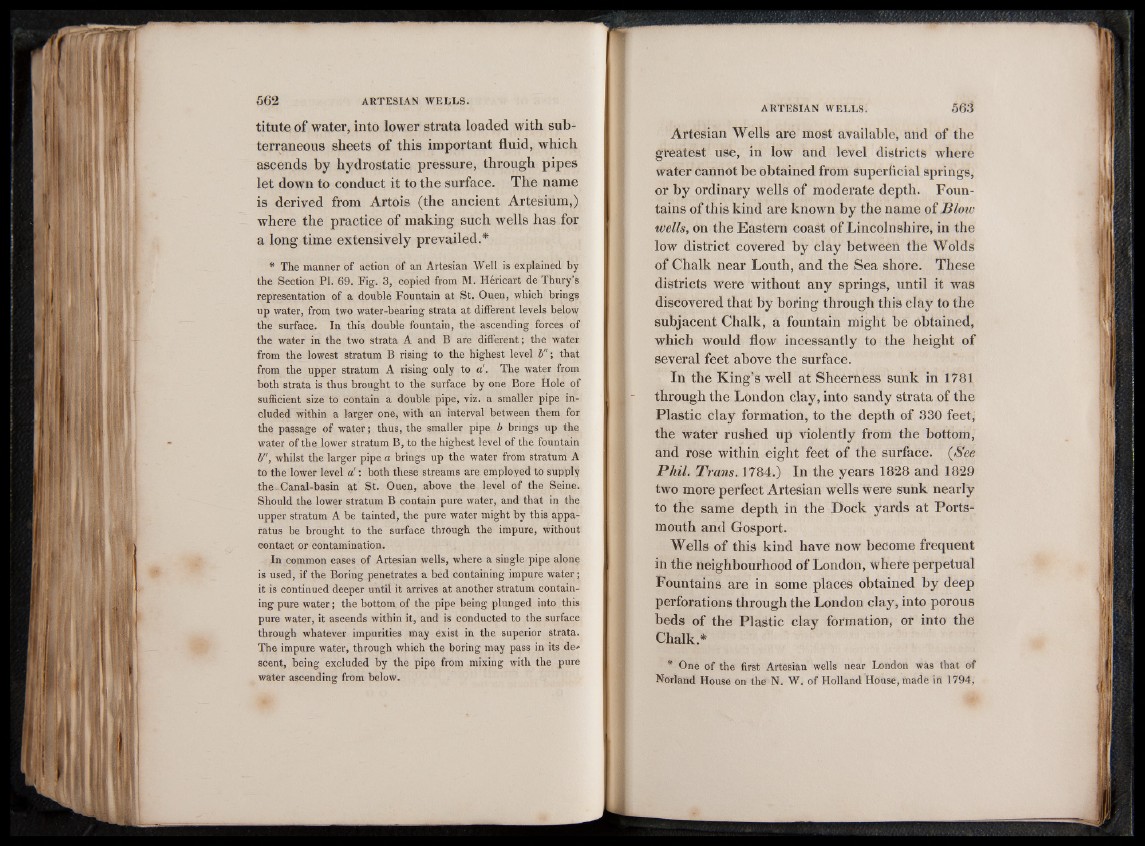
titute of water, into lower strata loaded with subterraneous
sheets of this important fluid, which
ascends by hydrostatic pressure, through pipes
let down to conduct it to the surface. The name
is deriyed from Artois (the ancient Artesium,)
where the practice of making such wells has for
a long time extensively prevailed.*
* The manner of action of an Artesian Well is explained by
the Section PI. 69. Fig. 3, copied from M. Hericart de Thury’s
representation of a double Fountain at St. Ouen, which brings
up water, from two water-bearing strata at different levels below
the surface. In this double fountain, the ascending forces of
the water in the two strata A and B are different; the water
from the lowest stratum B rising to the highest level b"; that
from the upper stratum A rising only to a1. The water from
both strata is thus brought to the surface by one Bore Hole of
sufficient size to contain a double pipe, viz. a smaller pipe included
within a larger one, with an interval between them for
the passage of water; thus, the smaller pipe b brings up the
water of the lower stratum B, to the highest level of the fountain
b", whilst the larger pipe a brings up the water from stratum A
to the lower level a ': both these streams are employed to supply
the. Canal-basin at St. Ouen, above the level of the Seine.
Should the lower stratum B contain pure water, and that in the
upper stratum A be tainted, the pure water might by this apparatus
be brought to the surface through the impure, without
contact or contamination.
In common cases of Artesian wells, where a single pipe alone
is used, if the Boring penetrates a bed containing impure water;
it is continued deeper until it arrives at another stratum containing
pure water; the bottom of the pipe being plunged into this
pure water, it ascends within it, and is conducted to the surface
through whatever impurities may exist in the superior strata.
The impure water, through which the boring may pass in its descent,
being excluded by the pipe from mixing with the pure
water ascending from below.
Artesian Wells are most available, and of the
greatest use, in low and level districts where
water cannot be obtained from superficial springs,
or by ordinary wells of moderate depth. Fountains
of this kind are known by the name of Bloiv
wells, on the Eastern coast of Lincolnshire, in the
low district covered by clay between the Wolds
of Chalk near Louth, and the Sea shore. These
districts were without any springs, until it was
discovered that by boring through this clay to the
subjacent Chalk, a fountain might be obtained,
which would flow incessantly to the height of
several feet above the surface.
In the King’s well at Sheerness sunk in 1781
through the London clay, into sandy strata of the
Plastic clay formation, to the depth of 330 feet,
the water rushed Up violently from the bottom,
and rose within eight feet of the surface. {See
Phil. Trans. 1784.) In the years 1828 and 1829
two more perfect Artesian wells were sunk nearly
to the same depth in the Dock yards at Portsmouth
and Gosport.
Wells of this kind have now become frequent
in the neighbourhood of London, where perpetual
Fountains are in some places obtained by deep
perforations through the London clay, into porous
beds of the Plastic clay formation, or into the
Chalk.*
* One of the first Artesian wells near London was that of
Norland House on the N. W. of Holland House, made in 1794,